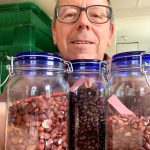What is your name? What are the main projects or organisations you are currently involved in? Can you briefly present their activity and your function?

I’m Nicolas Carton, a french agroecologist and self-proclaimed pulse ambassador. I started the initiative ‘Lumineuses’ in 2020 to promote pulse crops in the fields and in the kitchens:
– In the fields, setting up trials together with innovative farmers and helping them with post-harvest steps, communication and finding outlets.
– In the kitchens, sharing information and recipes for every person interested in eating – that makes a few!
I found a great platform and like-minded community through The Global Bean Project!
How is your work or organisation related to legumes?
I first gained experience in legume crops as an agricultural scientist working on cereal-legume intercrops and integration of legumes in crop rotations in France and Sweden. Then I’ve been advising organic soybean producers in Germany and France for a tofu company, and in parallel I was trialling pulse crops with farmers. As for the cooking, after many years playing around with peas, chickpeas, lentils, beans and faba beans in my private kitchen, I decided to take an online cooking course and I recently started giving workshops, which I enjoy a lot.
What do you think are the biggest challenges for producers and for consumers?
For farmers, there are still numerous agronomic issues but I think a lot of them can be addressed by translating and efficiently communicating existing research results as hands-on recommandations. Some difficult issues remain and will reinforce with time, like emerging pests and the weather unreliability due to climate change. We need to include adaptation to climate change in all aspects of cropping systems, where resilience is key.
Besides agronomy, if we want European farmers to grow more pulses, the biggest challenge I see is the lack of actors that are willing to take charge of the steps between the harvest and selling to retailers or consumers. Very few individual farmers have the will and possibility to care for all the steps from harvest to the final consumers. When a pulse crop is coming out of the combine harvester, the grain most often requires to be cleaned (from remaining green plant parts), dried as soon as possible, sorted (if grown as an intercrop), stored and packaged. Additionally, farmers need to be sure that there will be buyers for the products before they decide to grow new crops on a commercial scale.
In many countries, things are changing and we see more farmer groups, big and small companies or cooperatives investing in facilities for post-harvest management and securing outlets for new crops. This is one aspect we will discuss in the next Global Bean meeting (see below).
With a Swedish farmer in his experimental field. © Ann Jorneus, Sveriges Radio
For consumers, I think one big challenge is the lack of knowledge of the many ways pulses can be included in their diets and lack of confidence in the kitchen. I have the feeling that many people are afraid of cooking because they haven’t learned to improvise, to substitute one ingredient for another. In my cooking workshops and when sharing recipes, as in a newly started cookbook project together with Claudia from Heldenküche, I’m trying to provide home cooks with an understanding of the dishes (for instance, what makes a bean patty hold together and what are ways to give it a deep taste) so they can feel free to design their own recipes with the combinations of ingredients they prefer.
© Nicolas Carton @lumineuses_div
What fact(s) about legumes do you find most compelling for their promotion?
Pulses are so diverse (sizes, textures, tastes, colors) and can be cooked in thousands of ways, just look at the traditional recipes developed in almost all cultures of the world! Pulses are also very cheap compared to the animal products that took their place on our plates during the last century, and they are sources of proteins associated with fibre and carbohydrates rather than with saturated fats.
People are more aware of the environmental benefits of legumes than they used to be a few years ago, though often we don’t see the benefits through the lense of crop diversification. Growing more legumes (and other neglected crops) in cropping systems vastly dominated by cereals, rapeseed and sugar beets means bringing more diversity of habitats and resources for wildlife, including pollinators, along with sparing fertilisers and all inputs involved in pest and weed control. Diversity is the key!
Would you like to share specific information with the Global Bean club?
I’m very glad to be coordinating next Global Bean public meeting on the 15.11.22, a round table with very inspiring speakers presenting their successful initiatives increasing production and consumption of diverse pulses.
How did you fall in love with legumes?
I always loved the baked beans my father was “cooking” for me as a child. But the true aha-moment came a few months into my PhD on lupin-cereal intercrops,when my lab colleagues chose as a birthday present the book “savez-vous goûter… les légumes secs ? ». I was of course already convinced that legumes were of great importance, but I was studying lupin, mostly used in animal feed, and hadn’t fully realised the huge potential of pulses as human food. The book became my bible and turned me into a pulse nerd all at once!

Do you have a favourite legume and why? Tell us about your personal experiences with legumes.
It’s difficult to choose, there are so many great neglected varieties! Now that I live in El Empordà (Eastern Catalonia), I discovered the cowpea variety “Fesol de l’Ull Ros” and I love it for its thin skin, creaminess and subtle taste. Cowpeas (Vigna unguiculata) are a drought-resistant species that will probably wander North of its traditional cropping area when other beans become difficult to grow because of climate change. That variety used to be widely grown in the area where I live, but it got less used in the last decades because its harvest is difficult to mechanise. I want to get in touch with the small group of farmers maintaining its cropping tradition, to see how I can help.




